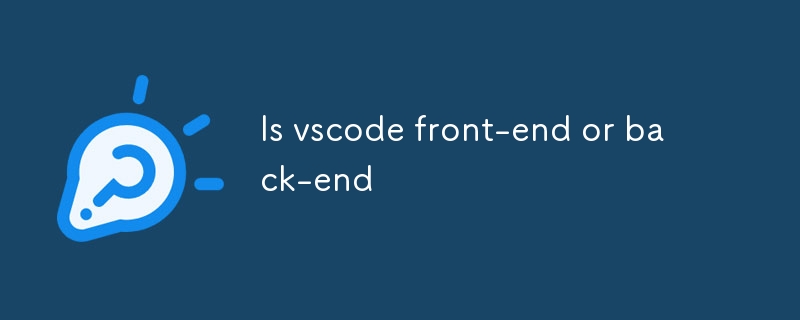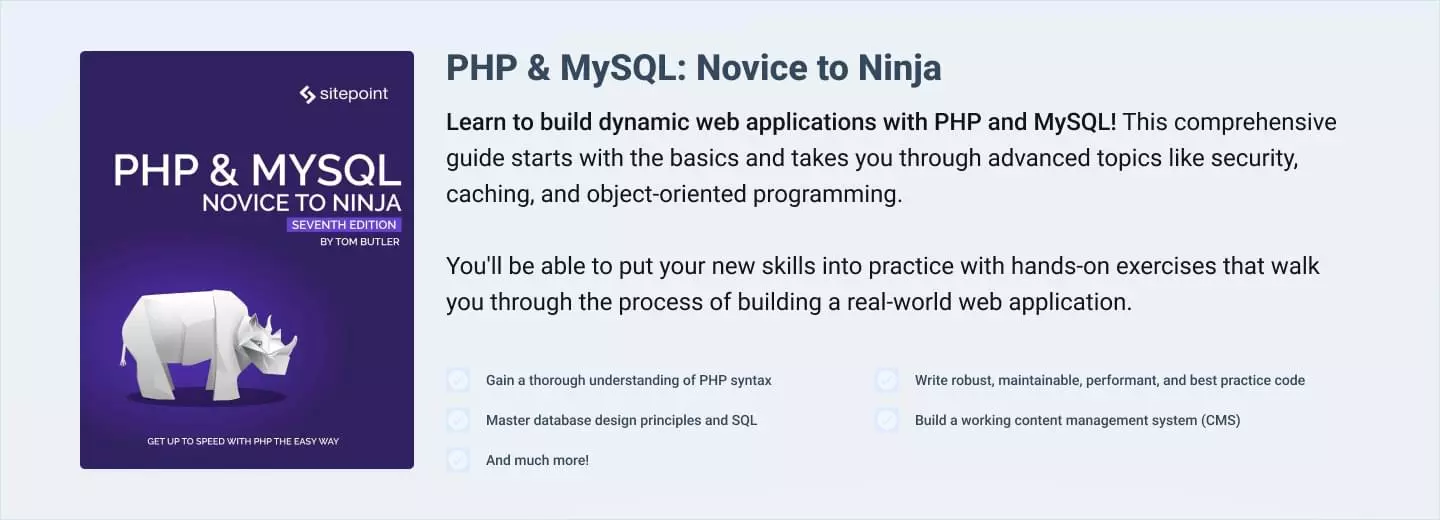Found a total of 10000 related content

Is vscode front-end or back-end
Article Introduction:VS Code's versatility supports both front-end and back-end development. Its extensibility allows customization for various languages and frameworks. Simultaneous front-end and back-end tasks are easily managed via workspaces and integrated terminal
2025-03-06
comment 0
923

Full-Stack Development with Laravel: Managing APIs and Frontend Logic
Article Introduction:In Laravel full-stack development, effective methods for managing APIs and front-end logic include: 1) using RESTful controllers and resource routing management APIs; 2) processing front-end logic through Blade templates and Vue.js or React; 3) optimizing performance through API versioning and paging; 4) maintaining the separation of back-end and front-end logic to ensure maintainability and scalability.
2025-04-28
comment 0
1083



Is golang frontend or backend
Article Introduction:Golang is mainly used for back-end development, but it can also play an indirect role in the front-end field. Its design goals focus on high-performance, concurrent processing and system-level programming, and are suitable for building back-end applications such as API servers, microservices, distributed systems, database operations and CLI tools. Although Golang is not the mainstream language for web front-end, it can be compiled into JavaScript through GopherJS, run on WebAssembly through TinyGo, or generate HTML pages with a template engine to participate in front-end development. However, modern front-end development still needs to rely on JavaScript/TypeScript and its ecosystem. Therefore, Golang is more suitable for the technology stack selection with high-performance backend as the core.
2025-07-08
comment 0
548

Setting up API Authentication with Laravel Sanctum?
Article Introduction:LaravelSanctum is a lightweight API certification system suitable for front-end and back-end separation projects. 1. The installation requires Laravel7.x or above. Install and publish configuration files and migration files through Composer, run migration and configure domain names and stateful settings as needed. 2. User login can generate a simple token or a personalized token with permissions, and use the createToken method to get the plainTextToken and return it to the front end. 3. To protect API routing, you need to add auth:sanctum middleware and manually call the tokenCan method to verify permissions. 4. Delete the current or all tokens when logging out, and the front-end needs to be cleared and saved
2025-07-09
comment 0
974

What is frontend security
Article Introduction:The reason why front-end security is easily overlooked is that many people think that the front-end is just a "display page", and the real important logic and data are on the back-end. However, with the popularity of the front-end separation architecture, the front-end has undertaken more and more data processing and interaction tasks, becoming a potential target of attackers. 1. XSS attack steals cookies or hijacks sessions by injecting malicious scripts, prevents the need to escape user input, use CSP, and avoids the need to directly insert DOM; 2. CSRF attack induces user operations by forging requests, prevents the need to use SameSiteCookies, add CSRFTokens, and checks the Referer header; 3. The risk of third-party dependency comes from vulnerable npm packages or CDN resources, prevents the need to scan dependencies regularly and avoids
2025-07-03
comment 0
640

What is a 'headless' software
Article Introduction:Header less software refers to a system or application without a user interface. It communicates with other systems through APIs to realize backend automation processing. Its core features are API-first design, front-end and back-end separation architecture, and no built-in UI layer. It is commonly found in less CMS, browsers and e-commerce platforms. It has the advantages of high flexibility, good performance, and easy to expand. It is suitable for multi-terminal unified content management or multi-platform interaction scenarios. Choosing a headless less solution can improve customization capabilities, but it also requires more development investment.
2025-07-11
comment 0
882

How to link terminal profiles with VSCode profiles?
Article Introduction:In VSCode, you can associate the terminal configuration file with the user profile by configuring the settings.json file. The specific steps are: 1. Understand the configuration file structure and make it clear that each Profile can set the terminal type independently; 2. Set the terminal.integrated.defaultProfile field in the settings.json of the corresponding Profile to specify the default terminal, and define the path and parameters of each terminal in terminal.integrated.profiles; 3. If the front-end project uses zsh and the back-end project uses bash, different terminals can be set for the two Profiles respectively; 4.
2025-07-18
comment 0
594

How to separate the front and back end of wordpress
Article Introduction:It is not recommended to directly modify the native code when separating WordPress front and back ends, and it is more suitable for "improved separation". Use the REST API to obtain data and build a user interface using the front-end framework. Identify which functions are called through the API, which are retained on the backend, and which can be cancelled. The Headless WordPress mode allows for a more thorough separation, but it is more cost-effective and difficult to develop. Pay attention to security and performance, optimize API response speed and cache, and optimize WordPress itself. Gradually migrate functions and use version control tools to manage code.
2025-04-20
comment 0
446

How to add custom fields to users
Article Introduction:To add custom user fields, you need to select the extension method according to the platform and pay attention to data verification and permission control. Common practices include: 1. Use additional tables or key-value pairs of the database to store information; 2. Add input boxes to the front end and integrate with the back end; 3. Constrain format checks and access permissions for sensitive data; 4. Update interfaces and templates to support new field display and editing, while taking into account mobile adaptation and user experience.
2025-07-06
comment 0
963

Must-Know Tech Stacks
Article Introduction:12 popular technology stacks worth learning in 2025 and a guide to making money quickly. In 2025, technology is developing rapidly, and choosing the right technology stack is crucial. This article will introduce 12 technology stacks that will attract much attention in 2025, and come with an AI Notion template guide to make money quickly. Whether you are a web developer, mobile application developer or expert in the AI/blockchain field, you can find a direction that suits you. 1. MERN stack (MongoDB, Express.js, React, Node.js) The MERN stack is the perfect solution for full-stack web development. It allows you to build the front-end and back-end of your website using JavaScript, thereby simplifying the development process and improving the efficiency of your application. Can
2025-01-11
comment 0
698

PHP Master | The MVC Pattern and PHP, Part 1
Article Introduction:Detailed explanation of Model-View-Controller (MVC) architecture model and PHP implementation examples
Core points
The MVC pattern is a software architecture pattern that separates the display of data from the methods of interacting with the data, allowing front-end and back-end developers to work on the same system without interfering with each other.
Because of its emphasis on separation of concerns and reusable code, MVC has been applied to web development, which encourages the development of modular systems to quickly update, add or delete features.
The MVC pattern contains three core parts: Model, View, and Controller. The model is the permanent storage of data, and the view is to view the data and determine its best
2025-02-24
comment 0
708

HTML `input` `required` Attribute for Mandatory Fields
Article Introduction:To set required fields in HTML forms, 1. Use the required attribute to achieve it; 2. This attribute is a Boolean type, without assignment, and is suitable for common input types such as text, email, password, etc.; 3. The browser will automatically verify when submitting, and if it is not filled in, it will be blocked and prompted; 4. The prompt information cannot be customized by default, and can be adjusted through the setCustomValidity() method of JavaScript; 5. Note that you cannot rely solely on front-end verification, the back-end still needs to verify the data; 6. The performance of the mobile terminal may be inconsistent, and it is recommended to test the target platform; 7. Avoid multiple required fields at the same time affecting the user experience.
2025-07-18
comment 0
831

Using the HTML5 `pattern` attribute for input validation regex.
Article Introduction:Using HTML5's pattern attribute allows for convenient front-end input verification without JavaScript. 1. The basic usage is to write regular expressions into the pattern attribute of the input tag, which is used to restrict the content of the text input box; 2. Regular expressions should be added to ^ and $ to ensure full match and avoid misjudgment; 3. It can provide clearer prompt information with the title attribute, but the mobile side may not display it; 4. Common application scenarios include verification of mobile phone numbers, postal codes, passwords, license plate numbers, etc., but back-end verification is still required to ensure data security.
2025-07-04
comment 0
291

How to convert XML to PDF on your phone?
Article Introduction:It is not easy to convert XML to PDF directly on your phone, but it can be achieved with the help of cloud services. It is recommended to use a lightweight mobile app to upload XML files and receive generated PDFs, and convert them with cloud APIs. Cloud APIs use serverless computing services, and choosing the right platform is crucial. Complexity, error handling, security, and optimization strategies need to be considered when handling XML parsing and PDF generation. The entire process requires the front-end app and the back-end API to work together, and it requires some understanding of a variety of technologies.
2025-04-02
comment 0
603

Exploring Different Input Types for HTML Forms
Article Introduction:The input type improves form experience and verification efficiency. HTML5 provides various input types such as text, password, email, etc., which are adapted to different scenarios such as username, password hiding, and email verification; supports number limited number input, date selection, checkbox multiple selection, radio single selection, file upload, range slider bar, color color selection; combines required, min/max, and pattern to achieve front-end verification to reduce the burden on the back-end; mobile terminals automatically adapt to keyboard types such as email display @ symbols, tel calls numeric keyboards; provide input-able option list, readonly lock fields, hidden through datalist
2025-07-06
comment 0
569

What Can You Do with PHP?
Article Introduction:PHP can be used for a variety of development tasks, especially in web development. Specifically, it includes: 1. Build dynamic websites and web applications, such as user login systems, e-commerce platforms and content management systems; 2. Integrate with databases such as MySQL to facilitate storage and retrieval of data; 3. Use frameworks such as Laravel or Symfony to improve security and scalability; 4. Create RESTful APIs and back-end services to support data interactions in front-end or mobile applications; 5. Write command-line scripts to implement timing tasks, data processing and file operations; 6. Participate in deployment process automation in DevOps, especially in a PHP-led environment.
2025-07-17
comment 0
784

Frontend Performance Optimization for Mobile Devices
Article Introduction:The performance optimization of the front-end mobile terminal needs to be based on the characteristics of the mobile terminal. 1. Reduce the number of requests and resource volume on the first screen, including merging JS/CSS files, using on-demand loading, compressing pictures and selecting appropriate formats; 2. Use caching strategies to reduce duplicate loading, such as setting up HTTP cache headers, using ServiceWorker precache, and local storage of interface data; 3. Optimizing rendering performance and interactive experience, avoiding forced synchronization of layouts and long tasks, simplifying page structure, and delaying non-critical animations; 4. Use lightweight frameworks and modern features, such as choosing Preact/Svelte, enabling TreeShaking, using native APIs, enabling HTTP/2 and Brotli compression.
2025-07-20
comment 0
383

Explain Laravel Passport vs Sanctum.
Article Introduction:Sanctum is lighter and suitable for SPA or mobile, while Passport is more powerful and suitable for OAuth2 services. 1. Passport supports third-party authorization for open API scenarios such as GitHub login, and Sanctum is suitable for front-end separation or mobile-side self-use APIs. 2. Passport is complex to install and configure client ID/Secret and token policies. Sanctum is simple to configure and publish migration and modify guard drivers. 3. Passport uses JWT to encrypt tokens without checking the library and verifying it. Sanctum plaintext storage tokens requires each query, but the management is more intuitive. 4. Passport is naturally stateless and suitable for cross-domain deployment, Sanc
2025-07-17
comment 0
819


















